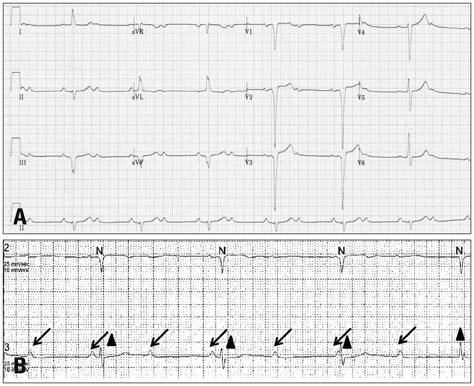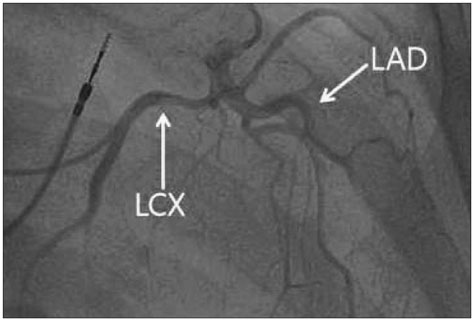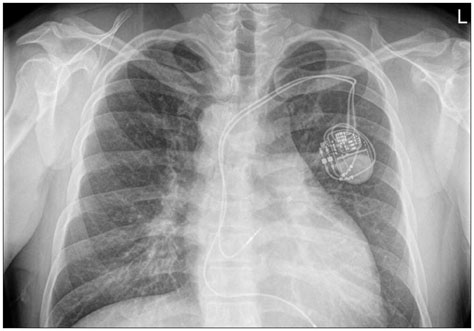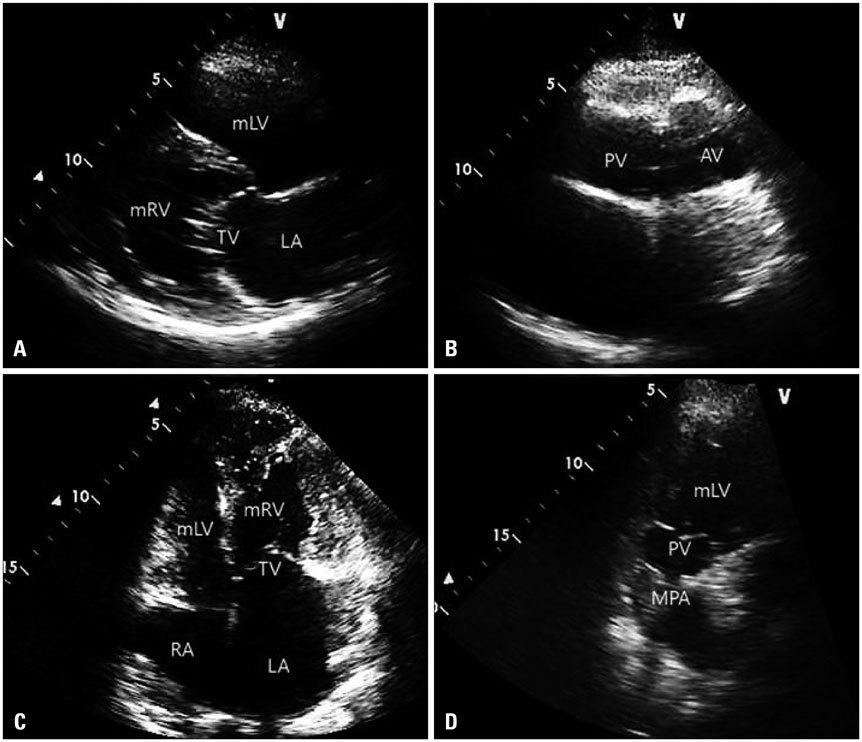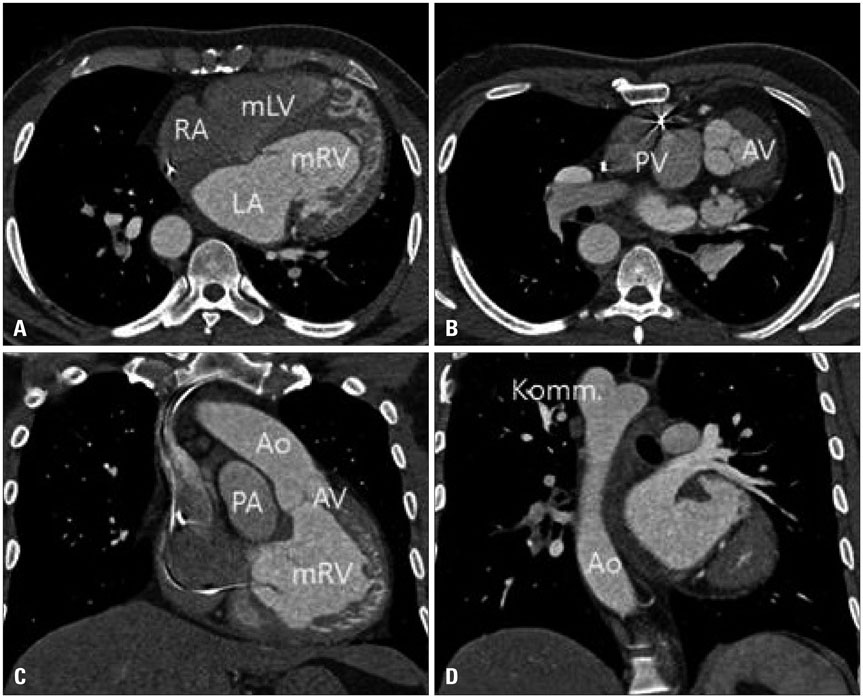J Cardiovasc Ultrasound.
2015 Mar;23(1):36-39. 10.4250/jcu.2015.23.1.36.
A Typical Case of L-Transposition of the Great Arteries Initially Presented as Complete Atrioventricular Block in Middle-Aged Man
- Affiliations
-
- 1Cardiovascular Center, Korea University Guro Hospital, Seoul, Korea. jinona@medimail.co.kr
- KMID: 2135405
- DOI: http://doi.org/10.4250/jcu.2015.23.1.36
Abstract
- L-transposition of the great arteries (L-TGA) is a rare congenital anomaly and could cause complete atrioventricular (AV) block at relatively younger age. We present a case of 43-year-old male who complained of dizziness due to complete AV block. We confirmed L-TGA using transthoracic echocardiography and cardiac computed tomography. Permanent pacemaker was inserted without complications. No invasive treatment including corrective surgery was performed because patient's cardiac function was almost normal and the symptom was completely resolved after pacemaker insertion.
MeSH Terms
Figure
Reference
-
1. Warnes CA. Transposition of the great arteries. Circulation. 2006; 114:2699–2709.2. Hornung TS, Calder L. Congenitally corrected transposition of the great arteries. Heart. 2010; 96:1154–1161.3. Anderson RH, Becker AE, Arnold R, Wilkinson JL. The conducting tissues in congenitally corrected transposition. Circulation. 1974; 50:911–923.4. Wilkinson JL, Smith A, Lincoln C, Anderson RH. Conducting tissues in congenitally corrected transposition with situs inversus. Br Heart J. 1978; 40:41–48.5. Graham TP Jr, Bernard YD, Mellen BG, Celermajer D, Baumgartner H, Cetta F, Connolly HM, Davidson WR, Dellborg M, Foster E, Gersony WM, Gessner IH, Hurwitz RA, Kaemmerer H, Kugler JD, Murphy DJ, Noonan JA, Morris C, Perloff JK, Sanders SP, Sutherland JL. Long-term outcome in congenitally corrected transposition of the great arteries: a multi-institutional study. J Am Coll Cardiol. 2000; 36:255–261.6. Presbitero P, Somerville J, Rabajoli F, Stone S, Conte MR. Corrected transposition of the great arteries without associated defects in adult patients: clinical profile and follow up. Br Heart J. 1995; 74:57–59.7. Beauchesne LM, Warnes CA, Connolly HM, Ammash NM, Tajik AJ, Danielson GK. Outcome of the unoperated adult who presents with congenitally corrected transposition of the great arteries. J Am Coll Cardiol. 2002; 40:285–290.8. Prieto LR, Hordof AJ, Secic M, Rosenbaum MS, Gersony WM. Progressive tricuspid valve disease in patients with congenitally corrected transposition of the great arteries. Circulation. 1998; 98:997–1005.9. Kilner PJ. Imaging congenital heart disease in adults. Br J Radiol. 2011; 84(Spec No 3):S258–S268.10. Hauser M, Bengel FM, Hager A, Kuehn A, Nekolla SG, Kaemmerer H, Schwaiger M, Hess J. Impaired myocardial blood flow and coronary flow reserve of the anatomical right systemic ventricle in patients with congenitally corrected transposition of the great arteries. Heart. 2003; 89:1231–1235.11. Murtuza B, Barron DJ, Stumper O, Stickley J, Eaton D, Jones TJ, Brawn WJ. Anatomic repair for congenitally corrected transposition of the great arteries: a single-institution 19-year experience. J Thorac Cardiovasc Surg. 2011; 142:1348–1357.e1.12. Hraska V, Duncan BW, Mayer JE Jr, Freed M, del Nido PJ, Jonas RA. Long-term outcome of surgically treated patients with corrected transposition of the great arteries. J Thorac Cardiovasc Surg. 2005; 129:182–191.13. Rutledge JM, Nihill MR, Fraser CD, Smith OE, McMahon CJ, Bezold LI. Outcome of 121 patients with congenitally corrected transposition of the great arteries. Pediatr Cardiol. 2002; 23:137–145.
- Full Text Links
- Actions
-
Cited
- CITED
-
- Close
- Share
- Similar articles
-
- A case of isolated congenitally corrected transposition of the great arteries with complete atrioventricular block
- Transposition of the Great Arteries: Historical Background
- Atrioventricular nodal re‑entrant tachycardia with a 2:1 atrioventricular block in a young man: What is the mechanism?
- Recent Issues of Complex Transposition of the Great Arteries
- A Case Report of Congenitally Corrected Transposition of Great Arteries: Morphologic and Functional Evaluation with Cardiac CT

